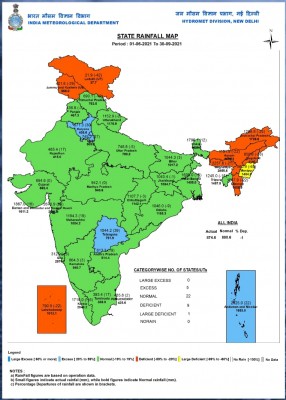
Guwahati/Agartala, Even as southwest monsoon rainfall in the country, according to the the India Meteorological Department (IMD), as a whole was "normal", six of the eight northeastern states witnessed deficient monsoon rains due to lack of rain bearing clouds and monsoon trough from the Bay of Bengal.
According to the IMD data, except Sikkim and Tripura, the six remaining northeastern states -- Arunachal Pradesh, Assam, Meghalaya, Nagaland, Manipur and Mizoram -- experienced deficit rains during the four-month long (June to September) southwest monsoon.
IMD (Tripura) Director Dilip Saha said that due to lack of rain bearing clouds, water vapour and monsoon trough from the Bay of Bengal, several northeastern states experienced deficient rainfall.
"However, there are at least 15 days left for the withdrawal of the southwest monsoon from the northeastern states. By the remaining two weeks, the deficiency of the rain might get covered before the formal withdrawal of the monsoon. The withdrawal of monsoon starts from the western region of the country and then from the northeastern region," Saha told IANS.
He said the monsoon trough accompanied by strong moisture incursion from Bay of Bengal mostly moved towards Odisha.
According to the IMD, during the four-month monsoon period, Manipur witnessed highest rainfall deficiency of 60 per cent, categorised as "large deficiency", followed by Nagaland (26 per cent), Arunachal Pradesh (25 per cent), Assam and Mizoram (both 22 per cent), Meghalaya (21 per cent) and Tripura (15 per cent).
Sikkim, like previous years, experienced excess rainfall of 12 per cent during the monsoon period.
As per the IMD norms, up to 19 per cent deficient or excess rainfall is categorised as normal. The northeastern region normally witnesses normal or heavy rainfall during the four months of the southwest monsoon, and few states, especially, Assam gets badly affected by the recurring annual floods.
This year, according to the Assam State Disaster Management Authority (ASDMA) officials, flood-related deaths in Assam were 10 while over 6.47 lakh people were affected in 22 of the state's 34 districts.
Monsoon floods also created havoc in various national parks in Assam, killing many wild and endangered animals, besides affecting domestic animals as well.
Agriculture experts said that at the moment there is no major threat to crops as irrigation facilities are more or less active in most parts of the northeastern region.
However, the Assam tea industry leaders apprehended that the prolonged drought-like situation during the pre-monsoon period (April-May) and in the beginning of the monsoon might cause a crop deficit this year, amounting to about 40 per cent, over the same period of 2019.


.jpeg)

